
(a)
Interpretation: The products for the given reaction including stereoisomers are to be drawn.
Concept introduction: Hydration of
The general steps involved in the hydration reaction are stated below:
• First, protonation of the alkene takes place to generate the carbocation.
• Formation of protonated alcohol.
• Deprotonation.
In this type of reaction, hydroxyl group attacks on the more substituted carbon.
Stereochemistry is defined as the arrangement of molecules in three dimensional space and its impact on
Answer to Problem 10.57P
The products for the given reaction including stereoisomers are shown below.
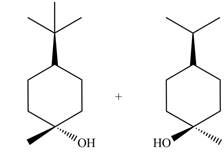
Explanation of Solution
Hydration of alkenes is one of the methods used for the formation of alcohol.
The general steps involved in the hydration reaction are stated below:
• First, protonation of the alkene takes place to generate the carbocation.
• Formation of protonated alcohol.
• Deprotonation.
In this type of reaction, hydroxyl group attacks on the more substituted carbon.
The given reaction is,

Figure 1
The products for the given reaction including stereoisomers are shown below.
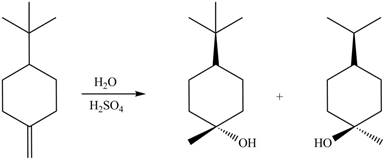
Figure 2
The products for the given reaction including stereoisomers are shown in Figure 2.
(b)
Interpretation: The products for the given reaction including stereoisomers are to be drawn.
Concept introduction: The reaction of hydrogen halide with alkene results in the formation of
Electrophilic addition reactions are those in which breaking of pi bond takes place to form new sigma bond. In this type of reaction, carbocation is formed during the formation of new bond.
Answer to Problem 10.57P
The products for the given reaction including stereoisomers are shown below.

Explanation of Solution
Electrophilic addition reaction follows Markovnikov’s rule. According to Markovnikov’s rule, the positive part of halogen acid attached to that carbon atom in
The steps involved in the electrophilic addition reaction are stated below:
• First, protonation of the alkene takes place to generate the carbocation.
• The halide ion will attack on the carbocation to give the final product.
The given reaction is,
![]()
Figure 3
The products for the given reaction including stereoisomers are shown below.
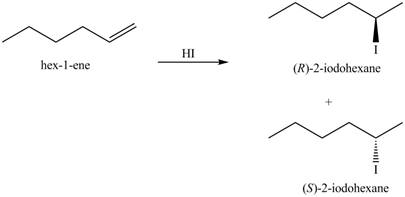
Figure 4
The products for the given reaction including stereoisomers are shown in Figure 4.
(c)
Interpretation: The products for the given reaction including stereoisomers are to be drawn.
Concept introduction: The addition of Halogens to alkenes is a stereospecific reaction. The resultant product is meso compound, if alkene is cis and addition of halogen is syn addition. If addition of halogen is anti, then the resultant products are racemic mixture. In case of trans alkene, the resultant product is meso, if addition of halogen is anti. The resultant products are racemic mixture, if the addition of halogen is syn.
Answer to Problem 10.57P
The products for the given reaction including stereoisomers are shown below.

Explanation of Solution
The general steps involved in the addition of Halogens to alkenes are stated below:
• The first step is the electrophilic attack of halide ion to form a halonium ion.
• The second step is the attack of halide ion from back side to open the halonium ion.
The given reaction is,

Figure 5
The products for the given reaction including stereoisomers are shown below.
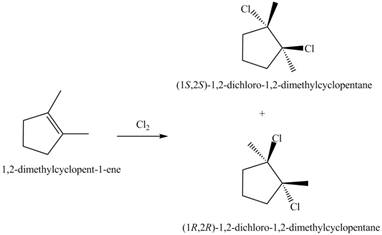
Figure 6
The products for the given reaction including stereoisomers are shown in Figure 6.
(d)
Interpretation: The products for the given reaction including stereoisomers are to be drawn.
Concept introduction: Hydroboration reaction is a two step reaction, which involves conversion of alkene into alcohol. This type of reaction follows anti-Markovnikov’s rule.
Anti markovnikov rule states that the positive part of acid gets attached to that carbon atom in
Anti addition is the addition of any atom from the opposite faces of the double bond of alkene, whereas syn addition is the addition of atom from the same side.
Answer to Problem 10.57P
The products for the given reaction including stereoisomers are given below.
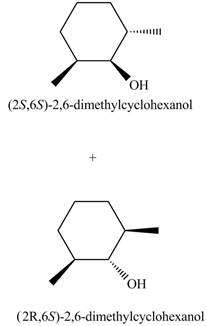
Explanation of Solution
During hydroboration reaction, if boron and hydrogen adds to the double bond of alkene from the same side then it leads to formation of syn addition, whereas if they add from the opposite side then it leads to anti-addition.
The given reaction is,

Figure 7
The products for the given reaction including stereoisomers are shown below.

Figure 8
The products for the given reaction including stereoisomers are shown in Figure 8.
(e)
Interpretation: The products for the given reaction including stereoisomers are to be drawn.
Concept introduction: The reaction of alkene with halogen and water results in the formation of halohydrin product.
Stereochemistry is defined as the arrangement of molecules in three dimensional space and its impact on chemical reactions. Anti stereochemistry is the addition of any atom from the opposite faces of the double bond of alkene, whereas syn addition is the addition of atom from the same side.
The general steps for the formation of halohydrin are stated below:
• The first step is the attack of halide ion to form a halonium ion.
• The second step is the attack of water from back side to open the halonium ion.
• The last step is deprotonation to give the halohydrin product.
Answer to Problem 10.57P
The product for the given reaction including stereoisomers is given below.

Explanation of Solution
The addition of halogens to alkenes is a stereospecific reaction. The resultant product is meso compound, if alkene is cis and addition of halogen is syn addition. If addition of halogen is anti, then the resultant products are racemic mixture. In case of trans alkene, the resultant product is meso, if addition of halogen is anti. The resultant products are racemic mixture, if the addition of halogen is syn addition.
The given reaction is,

Figure 9
The general steps for the formation of halohydrin are stated below:
• The first step is the attack of halide ion to form a halonium ion.
• The second step is the attack of water from back side to open the halonium ion.
• The last step is deprotonation to give the halohydrin product.
The products for the given reaction including stereoisomers are shown below.

Figure 10
The products for the given reaction including stereoisomers are shown in Figure 10.
(f)
Interpretation: The products for the given reaction including stereoisomers are to be drawn.
Concept introduction: The reaction of alkene with halogen and water results in the formation of halohydrin product.
Stereochemistry is defined as the arrangement of molecule in three dimensional and its impact on chemical reactions. Anti stereochemistry is the addition of any atom from the opposite faces of the double bond of alkene, whereas syn addition is the addition of atom from the same side.
The general steps for the formation of halohydrin are stated below:
• The first step is the attack of halide ion to form a halonium ion.
• The second step is the attack of water from back side to open the halonium ion.
• The last step is deprotonation to give the halohydrin product.
Answer to Problem 10.57P
The product for the given reaction including stereoisomers is given below.

Explanation of Solution
The addition of halogens to alkenes is a stereospecific reaction. The resultant product is meso compound, if alkene is cis and addition of halogen is syn addition. If addition of halogen is anti, then the resultant products are racemic mixture. In case of trans alkene, the resultant product is meso, if addition of halogen is anti. The resultant products are racemic mixture, if the addition of halogen is syn addition.
The given reaction is,

Figure 11
The general steps for the formation of halohydrin are stated below:
• The first step is the attack of halide ion to form a halonium ion.
• The second step is the attack of water from back side to open the halonium ion.
• The last step is deprotonation to give the halohydrin product.
The products for the given reaction including stereoisomers are shown below.

Figure 12
The products for the given reaction including stereoisomers are shown in figure 12.
(g)
Interpretation: The products for the given reaction including stereoisomers are to be drawn.
Concept introduction: Hydration of alkenes is one of the methods used for the formation of alcohol.
The general steps followed by hydration reaction are stated below:
• First, protonation of the alkene takes place to generate the carbocation.
• Formation of protonated alcohol.
• Deprotonation.
In this type of reaction, hydroxyl group attacks on the more substituted carbon.
Stereochemistry is defined as the arrangement of molecule in three dimensional and its impact on chemical reactions. Stereochemistry for the products is shown by the dashed and wedge lines. Dashed lines represent that the bond is far away from the plane, whereas wedge line represents the bond out of the plane and towards the observer. These lines are used to represent the stereochemistry of the compound.
Answer to Problem 10.57P
The products for the given reaction including stereoisomers are shown below.

Explanation of Solution
The addition of Halogens to alkenes is a stereospecific reaction. The resultant product is meso compound, if alkene is cis and addition of halogen is syn addition. If addition of halogen is anti, then the resultant products are racemic mixture. In case of trans alkene, the resultant product is meso, if addition of halogen is anti. The resultant products are racemic mixture, if the addition of halogen is syn addition.
The given reaction is,

Figure 13
The reaction of
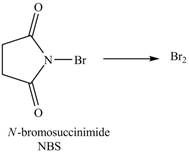
Figure 14
The general steps for the formation of halohydrin are stated below:
• The first step is the attack of halide ion to form a halonium ion.
• The second step is the attack of water from back side to open the halonium ion.
• The last step is deprotonation to give the halohydrin product.
The products for the given reaction including stereoisomers are shown below.

Figure 15
The attack of water on halonium ion is from back side that opens the bromonium ion to form mixture of enantiomers. This shows that the mode of addition in this reaction is anti which gives trans enantiomers.
The products for the given reaction including stereoisomers are shown in figure 15.
(h)
Interpretation: The products for the given reaction including stereoisomers are to be drawn.
Concept introduction: Hydration of alkenes is one of the methods used for the formation of alcohol.
The general steps followed by hydration reaction are stated below:
• First, protonation of the alkene takes place to generate the carbocation.
• Formation of protonated alcohol.
• Deprotonation.
In this type of reaction, hydroxyl group attacks on the more substituted carbon.
Stereochemistry is defined as the arrangement of molecule in three dimensional and its impact on chemical reactions. Stereochemistry for the products is shown by the dashed and wedge lines. Dashed lines represent that the bond is far away from the plane, whereas wedge line represents the bond out of the plane and towards the observer. These lines are used to represent the stereochemistry of the compound.
Answer to Problem 10.57P
The products for the given reaction including stereoisomers are shown below.
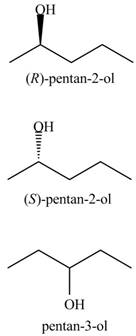
Explanation of Solution
Hydration of alkenes is one of the methods used for the formation of alcohol.
The general steps followed by hydration reaction are stated below:
• First, protonation of the alkene takes place to generate the carbocation.
• Formation of protonated alcohol.
• Deprotonation.
In this type of reaction, hydroxyl group attacks on the more substituted carbon.
The given reaction is,

Figure 16
The products for the given reaction including stereoisomers are shown below.
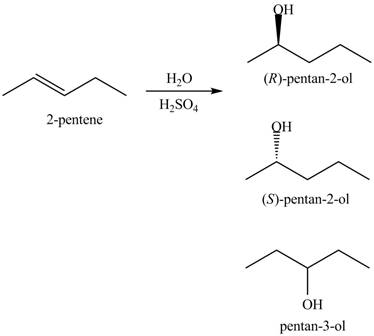
Figure 17
Stereochemistry is defined as the arrangement of molecule in three dimensional and its impact on chemical reactions. Stereochemistry for the products is shown by the dashed and wedge lines. Dashed lines represent that the bond is far away from the plane, whereas wedge line represents the bond out of the plane and towards the observer. These lines are used to represent the stereochemistry of the compound.
The products for the given reaction including stereoisomers are shown in figure 17.
Want to see more full solutions like this?
Chapter 10 Solutions
Organic Chemistry-Package(Custom)
- Predict the major products of the following organic reaction: NC Δ ? Some important Notes: • Draw the major product, or products, of the reaction in the drawing area below. • If there aren't any products, because no reaction will take place, check the box below the drawing area instead. • Be sure to draw bonds carefully to show important geometric relationships between substituents. Note: if your answer contains a complicated ring structure, you must use one of the molecular fragment stamps (available in the menu at right) to enter the ring structure. You can add any substituents using the pencil tool in the usual way. Click and drag to start drawing a structure. Х аarrow_forwardPredict the major products of this organic reaction. Be sure you use dash and wedge bonds to show stereochemistry where it's important. + ☑ OH 1. TsCl, py .... 文 P 2. t-BuO K Click and drag to start drawing a structure.arrow_forwardConsider this organic reaction: ( Draw the major products of the reaction in the drawing area below. If there won't be any major products, because this reaction won't happen at a significant rate, check the box under the drawing area instead. Click and drag to start drawing a structure. Х : а ค 1arrow_forward
- In the drawing area below, draw the major products of this organic reaction: If there are no major products, because nothing much will happen to the reactant under these reaction conditions, check the box under the drawing area instead. 1. NaH 2. CH3Br ? Click and drag to start drawing a structure. No reaction. : ☐ Narrow_forward+ Predict the major product of the following reaction. : ☐ + ☑ ค OH H₂SO4 Click and drag to start drawing a structure.arrow_forwardConsider this organic reaction: ... OH CI Draw the major products of the reaction in the drawing area below. If there won't be any major products, because this reaction won't happen at a significant rate, check the box under the drawing area instead. ☐ No Reaction. Click and drag to start drawing a structure. : аarrow_forward
- Consider the following reactants: Br Would elimination take place at a significant rate between these reactants? Note for advanced students: by significant, we mean that the rate of elimination would be greater than the rate of competing substitution reactions. yes O no If you said elimination would take place, draw the major products in the upper drawing area. If you said elimination would take place, also draw the complete mechanism for one of the major products in the lower drawing area. If there is more than one major product, you may draw the mechanism that leads to any of them. Major Products:arrow_forwardDraw one product of an elimination reaction between the molecules below. Note: There may be several correct answers. You only need to draw one of them. You do not need to draw any of the side products of the reaction. OH + ! : ☐ + Х Click and drag to start drawing a structure.arrow_forwardFind one pertinent analytical procedure for each of following questions relating to food safety analysis. Question 1: The presence of lead, mercury and cadmium in canned tuna Question 2: Correct use of food labellingarrow_forward
- Formulate TWO key questions that are are specifically in relation to food safety. In addition to this, convert these questions into a requirement for chemical analysis.arrow_forwardWhat are the retrosynthesis and forward synthesis of these reactions?arrow_forwardWhich of the given reactions would form meso product? H₂O, H2SO4 III m CH3 CH₂ONa CH3OH || H₂O, H2SO4 CH3 1. LiAlH4, THF 2. H₂O CH3 IVarrow_forward
 ChemistryChemistryISBN:9781305957404Author:Steven S. Zumdahl, Susan A. Zumdahl, Donald J. DeCostePublisher:Cengage Learning
ChemistryChemistryISBN:9781305957404Author:Steven S. Zumdahl, Susan A. Zumdahl, Donald J. DeCostePublisher:Cengage Learning ChemistryChemistryISBN:9781259911156Author:Raymond Chang Dr., Jason Overby ProfessorPublisher:McGraw-Hill Education
ChemistryChemistryISBN:9781259911156Author:Raymond Chang Dr., Jason Overby ProfessorPublisher:McGraw-Hill Education Principles of Instrumental AnalysisChemistryISBN:9781305577213Author:Douglas A. Skoog, F. James Holler, Stanley R. CrouchPublisher:Cengage Learning
Principles of Instrumental AnalysisChemistryISBN:9781305577213Author:Douglas A. Skoog, F. James Holler, Stanley R. CrouchPublisher:Cengage Learning Organic ChemistryChemistryISBN:9780078021558Author:Janice Gorzynski Smith Dr.Publisher:McGraw-Hill Education
Organic ChemistryChemistryISBN:9780078021558Author:Janice Gorzynski Smith Dr.Publisher:McGraw-Hill Education Chemistry: Principles and ReactionsChemistryISBN:9781305079373Author:William L. Masterton, Cecile N. HurleyPublisher:Cengage Learning
Chemistry: Principles and ReactionsChemistryISBN:9781305079373Author:William L. Masterton, Cecile N. HurleyPublisher:Cengage Learning Elementary Principles of Chemical Processes, Bind...ChemistryISBN:9781118431221Author:Richard M. Felder, Ronald W. Rousseau, Lisa G. BullardPublisher:WILEY
Elementary Principles of Chemical Processes, Bind...ChemistryISBN:9781118431221Author:Richard M. Felder, Ronald W. Rousseau, Lisa G. BullardPublisher:WILEY





